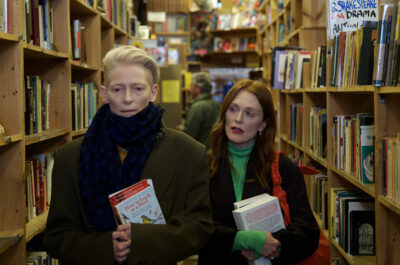FLOW may be the best animated film of the year.
It has been another excellent year for animated features. Inside Out 2, The Wild Robot, Look Back, Art College 1994, Chicken for Linda and Memoir of a Snail stand out; Moana 2 just had a record-setting weekend; and we still have The Lord of the Rings: The War of the Rohirrim, The Colors Within and The Day the Earth Blew Up: A Looney Tunes Movie to look forward to.
But, as Yoda said, “there is another.” The adventure-fantasy Flow follows a courageous cat after his home is devastated by a great flood. Teaming up with a capybara, a lemur, a bird, and a dog to navigate a boat in search of dry land, they must rely on trust, courage, and wits to survive the perils of a newly aquatic planet. From the boundless imagination of the award-winning Latvian filmmaker Gints Zilbalodis (Away), Flow is a thrilling animated spectacle as well as a profound meditation on the fragility of the environment and the spirit of friendship and community. Steeped in the soaring possibilities of visual storytelling, it is a feast for the senses and a treasure for the heart and we open it this Friday at the Laemmle Claremont, Glendale, Monica Film Center, and Newhall.
“Critic’s Pick! Grade: A! A movie brimming with sentiment but not sentimentality, this is one of the most moving animated films in recent memory, and, beyond that, groundbreaking too. The anthropomorphic animal characters of 21st century U.S. animated features have nothing on the animal stars of ‘Flow.'” – Christian Blauvelt, Indiewire
“At the risk of sounding hyperbolic, there’s something about the purity of great animated storytelling that can shatter your heart and then make it whole again. (Think Toy Story 3.) Latvian director Gints Zilbalodis’ captivating second feature, Flow, is that kind of marvel, a vividly experiential white-knuckle survival adventure that takes place in a world on the brink of ruin. Told entirely without dialogue, this tale of a cat that evolves from self-preservation to solidarity with a motley crew of other species is something quite special” – David Rooney, The Hollywood Reporter
“Flow is as hard to resist as a pair of plaintive, saucer-shaped eyes peering out from a bundle of fur. Gints Zilbalodis’s second feature is a rousing animated adventure in which a devastating flood obliges an independent cat to seek allies among the animal kingdom. Technical virtuosity is matched by storytelling vigour and dramatic heft in a film with a ready appeal to ailurophiles and animal lovers of all ages.”- Allan Hunter, Screen Daily
SABBATH QUEEN, the fascinating new documentary about a radical queer rabbi, opens this week with copious Q&A’s and an Inside the Arthouse interview.
Sabbath Queen, the new documentary filmed over two decades, follows Rabbi Amichai Lau-Lavie’s epic journey as the dynastic heir of 38 generations of Orthodox rabbis, including the Chief Rabbis of Israel. He is torn between rejecting and embracing his destiny and becomes a drag queen rebel, a queer bio-dad and the founder of Lab/Shul—an everybody-friendly, God-optional, artist-driven, pop-up experimental congregation.
Sabbath Queen followsAmichai on his lifelong quest to creatively and radically reinvent religion and ritual, challenge patriarchy and supremacy, champion interfaith love, and stand up for peace. The film interrogates what Jewish survival means in a difficult, rapidly
changing 21st century.
“How [Amichai] went from the Radical Faeries’ joyous, transgressive vision of queerness — which led to creating his drag alter ego, Rebbetzin Hadassah Gross — to embracing Conservative Judaism is the subject of Sandi DuBowski’s fascinating look at the act of questioning yourself and your family, your surroundings and your decisions.” ~ Elisabeth Vincentelli, New York Times
“This fast-paced, well-shot doc does place its finger on the quickening pulse of an ever-wider gap between liberalizing Western social values and the Orthodox sphere that believes they are antithetical to Judaism.” ~ Dennis Harvey, Variety
“The director delicately contextualizes his subject’s desired legacy by threading Lau-Lavie’s harrowing familial history into the narrative.” ~ Robyn Bahr, Hollywood Reporter
The regular engagement starts tomorrow at the Royal, and we are also showing the film December 9 at the NoHo, December 10 and 12 in Glendale, and December 11 at the Town Center. Director Sandi Simcha Dubowski (Trembling Before G-d) was interviewed for Greg Laemmle and Raphael Sbarge’s Inside the Arthouse podcast (the episode will be out Friday). He and protagonist Rabbi Amichai Lau-Lavie will participate in Q&A’s at multiple screenings along with special guests.
Thursday, December 5th at 7PM
Royal Theater — Q&A with director Sandi DuBowski and Amy Ziering
Award-winning investigative filmmaker and activist Amy Ziering is the woman behind the last decade’s most important films about sexual assault that have directly impacted American culture and politics. Ziering’s work is a lightning rod for conversation with lauded works such as The Invisible War, The Hunting Ground, The Bleeding Edge, On the Record, and Allen v. Farrow. Ziering is the recipient of countless prestigious awards including an Oscar nomination, two Emmy awards, a Peabody, an Independent Spirit Award, a duPont-Columbia award, and the George Polk Award.
Friday, December 6th at 7:10PM
Royal Theater — Q&A with director Sandi DuBowski.
Saturday, December 7th at 7:10PM
Royal Theater — Q&A with director Sandi DuBowski and protagonist Rabbi Amichai Lau-Lavie with journalist Jessica Yellin.
Jessica Yellin, the founder of News Not Noise. For years, Yellin worked in network news at ABC, MSNBC, and CNN, where she was the Chief White House Correspondent.
Saturday, December 7th, 4pm – 5.45pm
Afternoon SoulSpa led by Rabbi Amichai Lau-Lavie — a meditative spa for soul and body, which is an adaptation of the Shabbat day service into an interactive musical experience which is everybody-friendly and God-optional, offering grounding, gratitude and contemplative conversations to lift up healing and hope. Location in Sawtelle. If you are interested email: hello@sabbathqueen.com.
Sunday, December 8th Sabbath Queen Editing Masterclass 10:30AM–12:30PM
Francisco Bello ACE, Jeremy Stulberg ACE, Kristin Feely, Sandi DuBowski, Brian Kates ACE
At the Laemmle Royal with Editors/Writers Francisco Bello ACE and Jeremy Stulberg ACE, Editor Kyle Crichton, and director Sandi DuBowski to discuss the process of crafting a longitudinal documentary two decades in the making. Hosted by Brian Kates ACE. Moderated by Kristin Feeley, Director, Documentary Film and Artist Programs, Sundance Institute. In association with Sundance Institute Documentary Film Program, ADE, BIPOC Doc Editors, Karen Schmeer Editing Fellowship, Documentary Producers Alliance. RSVP here.
Sunday, December 8th at 1:20PM
Royal Theater — Q&A with director Sandi DuBowski, protagonist Rabbi Amichai Lau-Lavie, and Caroline Libresco.
Presented by Jewish Story Partners.
Caroline Libresco is Co-Founder and Head of Granting and Programs of Jewish Story Partners. She is a leading film festival curator, producer, story advisor, and program strategist who recently wrapped nineteen years as a lead programmer at the Sundance Film Festival. Caroline is a member of the Academy of Motion Picture Arts and Sciences, where she serves on the Documentary Branch Executive Committee.
Sunday, December 8th at 7:10PM
Royal Theater — Q&A with director Sandi DuBowski, protagonist Rabbi Amichai Lau-Lavie and Rabbi Sharon Brous.
Rabbi Sharon Brous is the senior and founding rabbi of IKAR, author of The Amen Effect, who offered the invocation at the DNC and Women’s March. She was named #1 on the Newsweek / The Daily Beast list of most influential Rabbis in America.
Monday, December 9th at 7PM
Laemmle Noho — Q&A with director Sandi DuBowski and Sabbath Queen composer Joel Goodman.
An Emmy-winner and four-time Emmy nominee known for a deeply nuanced sound filled with intricate subtleties, Goodman’s diverse body of work includes scores to over 150 films and television programs that have received 5 Oscar nominations, 30 Emmy awards and over 40 Emmy nominations. He has scored over 40 films for HBO and composed the Main Theme for the long-running and critically acclaimed PBS series American Experience.
Tuesday, December 10th at 7PM
Laemmle Glendale — Q&A with director Sandi DuBowski and Damona Hoffman
Celebrity dating coach Damona Hoffman has been coaching singles on how to find love online and offline for over 15 years. Her articles appear regularly in The LA Times and The Washington Post. Plus, she’s a regular on-air contributor to The Drew Barrymore Show, NPR, and NBC’s Access Daily. Damona also starred in two A+E Networks’ TV shows: #BlackLove and A Question of Love. Her weekly podcast Dates & Mates has been featured in Cosmopolitan, Huff Post, Bustle and tops the charts in the Relationships category on the major podcast platforms.
Wednesday, December 11th at 4PM and 7PM
Laemmle Town Center in Encino — Q&A with director Sandi DuBowski at 4pm and Sandi DuBowski and Gabe Dunn at 7pm
Gabe Dunn is an American writer, podcaster, actor, and filmmaker. Since 2014, Dunn has hosted the YouTube comedy show and podcast Just Between Us with fellow former BuzzFeed writer Allison Raskin. Dunn also hosts the podcast Bad with Money, which launched in 2016 and which primarily focuses on personal finances, while also discussing subjects including poverty and economic oppression. Their debut young adult novel I Hate Everyone but You, co-authored with Raskin, was published in 2017 and made The New York Times bestseller list.
Thursday, December 12th at 7PM
Laemmle Glendale — Q&A with director Sandi DuBowski
MY SWEET LAND Q&A’s at Laemmle Glendale.
SABBATH QUEEN filmmaker Sandi DuBowski in Person for Q&A’s.
Sabbath Queen Q&A’s:
5-Dec 7:00 Royal, Sandi Simcha Dubowski with Amy Ziering, Producer/Director
6-Dec 7:10 PM Royal Sandi with Gabe Dunn
7-Dec 7:10 PM Royal Sandi with Rabbi Amichai Lau-Lavie and Jessica Yellin, political journalist
8-Dec 1:20 PM Royal Sandi with Rabbi Amichai Lau-Lavie and Carolline Libresco, film festival curator
8-Dec 7:10 PM Royal Sandi with Rabbi Amichai Lau-Lavie and Rabbi Sharon Brous, Senior & Founding Rabbi, IKAR
9-Dec 7:00 PM NoHo Sandi with Joel Goodman, the film’s composer
10-Dec 7:00 PM Glendale Sandi with Damona Hoffman, Official Love Expert, The Drew Barrymore Show
Tickets for THE ROOM NEXT DOOR, Almodóvar’s first English-language film, go on sale on Friday.
On December 20th we are opening Pedro Almodóvar’s first movie in English, The Room Next Door, at the Royal. We’ll bring it to Claremont, Glendale, Newhall, North Hollywood, and Encino in January. Julianne Moore and Tilda Swinton star as two friends who reconnect after decades apart and embark on an unusual new phase of their friendship. Writing in Time Magazine, Stephanie Zacharek describes how “the colors of The Room Next Door are its secret message, a language of pleasure and beauty that reminds us how great it is to be alive. If it’s possible to make a joyful movie about death, Almodóvar has just done it.”

“The Room Next Door, as driven by the scalding humanity of Swinton’s performance, lifts you up and delivers a catharsis. The movie is all about death, yet in the unblinking honesty with which it confronts that subject, it’s powerfully on the side of life.” ~ Owen Gleiberman, Variety
“In these intensely moving moments it feels as if the two artists — [James] Joyce and Almodóvar — are connecting across time, desperate to express the ineffable, and keen to capture a creative moment that honours both the living and the dead.” ~ Kevin Maher, Times

“The Room Next Door turns into something spiky, unnerving, and at times joyously silly.” ~ Leo Robson, New Statesman
Almodóvar, Moore, and Swinton spoke about the film over the weekend at a Deadline Contenders panel discussion. “It’s wonderful. He really honors the female experience,” said Moore. “I think it’s something that he talks about, sitting under the kitchen table when his mother was talking to her friends and absorbing those stories and how powerful they were, and understanding that point of view. I think he’s always in that feminine point of view. Like I said, he honors that world. You feel very, very seen as an actor when you work with Pedro.”

“I’m a very dull or heady director,” said Almodóvar. “I say to the actors many, many, many things, and what I learned about these two is that perhaps I don’t need to say so much information to the actors. There was one very important [scene of Moore reading] the letter at the end. For me, it was very important. I was almost crying when I talked to her and I said, ‘Well, Julianne, this is what I want for this letter.’ [She] said, ‘Pedro, please let me do it, and after that, you give me all the indications.’ And she was right. When she just read it, I mean, I couldn’t believe it. I didn’t intervene, but it was more than perfect. So I learned by then that perhaps I don’t need to tell them so many things to the actors.”
INSIDE THE ARTHOUSE ~ new podcast episode with Professor Ross Melnick on the 100th anniversary of Arthouse Cinema.
The newest episode of Inside the Arthouse just dropped and it’s a fascinating one. Hosts Greg Laemmle and Raphael Sbarge discuss the centenary of arthouse film with professor, historian, author and Academy Film Scholar Ross Melnick. It’s a lively conversation about the amazing history of arthouse film — Where it started, how far it’s come, and where is it today. Laemmle, third generation arthouse theater owner, adds his perspective, as the trio explores the last century considers the future of arthouse.
Here’s a taste from the beginning of their conversation:
ROSS MELNICK: The history of arthouse theaters is about a hundred years old. It really starts around 1925 with Simon Gould and the film guild and the beginning of what were then called “little cinemas.” So the little cinemas grew out of what was called the “little theaters.” Little theaters were performing arts theaters across the country. There were almost 5000 of them.
RAPHAEL SBARGE: Like vaudeville, kind of?
ROSS MELNICK: No, actually, literally for performing arts. For plays and performances that were avant-garde, experimental, off of the…mainstream. And there’s a growing movement in the ’20s to kind of push away from mainstream narratives and create theaters, legitimate theaters, that were for live performances. This is across the country. And so, inspired by little theaters, little cinemas grew, sometimes even in previously legitimate houses, to start showing films that were also experimental, avant-garde and, in this case, often foreign. They were sort of growing out of an interest in foreign films and if you — with the risk of boring you, let me take you back just a few years earlier, which is that World War I happens between ’14 and ’18. And when it’s over there’s a huge anti-German sentiment in the United States.
GREG LAEMMLE: Massive.
ROSS MELNICK: Massive, to say the least. And no one wants to show German films. The only person that’s willing to show a German film is himself a German-American. A guy named Samuel “Roxy” Rothafel, who most people know as Roxy and who, of course, is the person who created Radio City Music Hall. He founded it. He ran the Roxy, the Capitol, the Strand, the Rialto, the Rivoli. All the major movie houses or many of the major movie houses in New York were run by Roxy. And when Roxy, underneath Samuel Goldywn — we’ll come back to Samuel Goldywn and later we’ll talk about a different company that his progeny ran — but when Roxy ran the Capitol Theater, he was really interested in this movie called Madame Du Barry. It’s an Ernst Lubitch film. 1919. Roxy saw it and said, “I’m going to bring this movie here.” And he took that nine-reel film, and he cut it to six. He made new inter-titles…and he released it as Passion. The Capitol Theater in New York was 5,300 seats.
RAPHAEL SBARGE: Oh, my God.
ROSS MELNICK: So it’s the largest theater in the United States. It was also a trade industry darling…and Roxy was running it and thought, “I’m going to bring this film.” So it broke the unofficial German boycott, the anti-German boycott, and suddenly there was this massive hit of a foreign film.
Watch the whole conversation here:
Steve McQueen’s masterful BLITZ opens Friday.
Tomorrow we open Blitz, the latest film English filmmaker Steve McQueen (Shame, 12 Years a Slave, Occupied City), at the Claremont, Glendale, Monica Film Center, Newhall, and Town Center. Starring Saoirse Ronan, it follows the stories of a group of Londoners during the events of the British capital bombing in World War II. Top film critics have been singing its praises:
“I’ve been to whole film festivals with less cinema than Steve McQueen packs into just two hours.” ~ William Bibbiani, TheWrap
“The quiet puncturing of the myth of WWII solidarity on the homefront feels nearly as visceral a shock to the system… It’s not Blitz’s sensory-overload sturm und drang that leaves you gasping for breath. It’s the sneak attack.” ~ David Fear, Rolling Stone
“McQueen makes a point of integrating into the film what is rarely seen in movies of this sort: a sharp depiction of racism among Londoners, the enraging sort that has so calcified it still surfaces when people are just trying to survive.” ~ Alissa Wilkinson, New York Times
“Blitz is a welcome reminder that a bruised, searching and flawed home front, in the waning days of empire, was its own fascinating emotional terrain too.” ~ Robert Abele, Los Angeles Times
“This is a movie about the way resilience can blossom from vulnerability. No child asks to be a victim of war; sometimes survival, with your soul intact, is the best possible outcome.” ~ Stephanie Zacharek, TIME Magazine
“Blitz, while not exactly a movie for children, is nonetheless a story about a child, and it has powerful moments of wonderment, humor and even joy.” ~ Justin Chang, NPR
“Arguably the most heroic character in the film is the city. And Blitz is, instantly, one of the great “London Movies.” ~ Kevin Maher, Times (UK)
- « Previous Page
- 1
- 2
- 3
- 4
- 5
- 6
- …
- 44
- Next Page »
